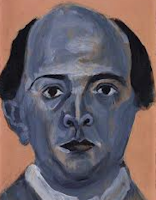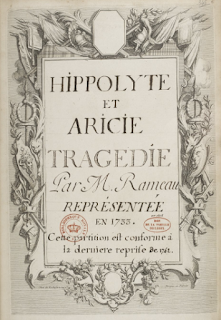Schoenberg - Moses und Aron
ONP Bastille, Monday October 26 2015
Conductor: Philippe Jordan. Production: Romeo Castellucci. Moses: Thomas Johannes Mayer. Aron: John Graham-Hall. Ein junges Mädchen: Julie Davies. Eine Kranke: Catherine Wyn-Rogers. Ein junger Mann: Nicky Spence. Der Nackte Jüngling: Michael Pflumm. Ein Mann: Chae Wook Lim. Ein anderer Mann, Ephraimit: Christopher Purves. Ein priester: Ralf Lukas. Vier Nackte Jungfrauen: Julie Davies, Maren Favela, Valentina Kutzarova, Elena Suvorova. Drei Älteste: Shin Jae Kim, Olivier Ayault, Jian-Hong Zhao. Sechs Solostimmen: Béatrice Malleret, Isabelle Wnorowska-Pluchart, Marie-Cécile Chevassus, John Bernard, Chae Wook Lim, Julien Joguet. Sets, costumes and lighting: Romeo Castellucci. Orchestra and Chorus of the Opéra National de Paris. Maîtrise des Hauts-de-Seine, Paris Opera children’s chorus.
I am ashamed to say that in all my long years I had never taken the time to listen to Moses und Aron. It was criminal negligence and I regret it now: last night I discovered a magnificent score, magnificently played and sung.
Six years ago, Nicolas Joel chose to open his directorship of the Paris Opera with Gounod’s Mireille in (I wrote at the time) “a staging that seemed (in the context of the change of management at the ONP, from Mortier to Joel) to be almost aggressively outdated and provincial.” Stéphane Lissner’s decision to open his tenure with Moses und Aron, originally to be directed by the late Patrice Chéreau and now, following Chéreau’s untimely death, by Romeo Castellucci, has been hailed hopefully by at least one newspaper critic as a sign of “the return of theatre to the Paris Opera.” Certainly, if this is a sign of what’s to come, in terms both of repertoire and of staging, things are looking up.
Romeo Castellucci’s production has gone down well with the press (and was, I read, only booed by a minority on the opening night, which is significant). If anything, while faithful, in its modern way (no palm trees or tea-towels on heads, thank goodness), to the text, it highlights the fretful, shifting, multi-layered ambiguities in Schoenberg’s thorny – and sometimes wordy - libretto. For a start, nearly all of act one is set more or less hazily - depending on how strongly lit - behind a gauze ("Milk of Magnesia," said a friend). The set is a seamless, open white space – infinitely white, therefore - with no props. At the start, a reel-to-reel tape recorder is lowered down in a spotlight, and the black tape begins to spill into Aron’s hands: the word of God, probably, that he is supposed to help Moses transmit to the people who, milling around, generously robed and hooded in white, bring to mind a flock of sheep.
Words are projected on the centre of the gauze: sometimes, slowly, words from the text; later, faster and faster successions of synonyms, or what seem to be just random nouns. The staff and snake appear as a large, 2001: A Space Odyssey spaceship also lowered down, sections of it rotating. Viscous, black liquid, oil or ink, spills from one end on to Moses’s hand: his leprosy.
In act two the tape and the ink, under Aron’s stewardship (and compromise) in Moses’s absence, gradually take over. Ink is poured from plastic jerrycans on the virgins, like a demonic anointment or baptism; extras, dressed in white, descend into a rectangular pool of ink and come out black; ink is smeared on floors and white flags and even poured on the back of the gigantic (one-and-a-half tonnes, we’re told) but placid Charolais bull led in to represent the Golden Calf. The orgy is merely hinted at (fortunately, as on-stage orgies are rarely convincing): at one point, the curved rear of the stage cracks open neatly at mid-height, leaving a horizontal slit through which slithering bodies can be seen; later, a single nude girl is lain before the bull while dancers in white, some of them handicapped, perform intricate gymnastics on the inky floor.
Aron is not only covered in ink and inky tape, like a gull in a slick, but eventually, against a majestic backdrop of snowy mountains (scaled by extras on ropes, like skyscraper window-cleaners), just before Moses comes down with the commandments, appears as a shaman in a costume of black tape (imitating raffia or straw) and a mask. During the ensuing argument, stage-hands clean the blackened stage with squeegee mops, leaving the word of the law in large letters embossed in the floor.
So there’s a series of undeniably striking images and the production is intriguing and coherent; but I wasn’t alone in growing, by the end, a bit fed up with all the baptisms in ink (“looks like 'Moses meets the giant squid'" said my neighbour) and I’d agree with those who have found the production just a bit too self-consciously aesthetic and a bit too static, pushing the work towards oratorio. A DVD would still be welcome, for both the images (sorry, Moses) and the music.
Thomas Johannes Mayer and John Graham-Hall were both excellent principals, though the latter, while commendably valiant, was, like many, nearly defeated by the scale of the Bastille. Secondary roles were carefully cast. But the triumph of the evening belonged to the chorus, orchestra, conductor and above all Schoenberg’s magnificent score, played with astonishing, crystalline clarity and legibility and sung with commitment and force.
The house was full and the audience applauded and cheered loudly and at length. So much for those who continue to claim that such “difficult” works are box-office poison, and that what opera audiences want is more Bellini, Verdi and Puccini. Let’s hope Stéphane Lissner will carry on as he has begun.
Maestro Wenarto sings Erwartung.
Conductor: Philippe Jordan. Production: Romeo Castellucci. Moses: Thomas Johannes Mayer. Aron: John Graham-Hall. Ein junges Mädchen: Julie Davies. Eine Kranke: Catherine Wyn-Rogers. Ein junger Mann: Nicky Spence. Der Nackte Jüngling: Michael Pflumm. Ein Mann: Chae Wook Lim. Ein anderer Mann, Ephraimit: Christopher Purves. Ein priester: Ralf Lukas. Vier Nackte Jungfrauen: Julie Davies, Maren Favela, Valentina Kutzarova, Elena Suvorova. Drei Älteste: Shin Jae Kim, Olivier Ayault, Jian-Hong Zhao. Sechs Solostimmen: Béatrice Malleret, Isabelle Wnorowska-Pluchart, Marie-Cécile Chevassus, John Bernard, Chae Wook Lim, Julien Joguet. Sets, costumes and lighting: Romeo Castellucci. Orchestra and Chorus of the Opéra National de Paris. Maîtrise des Hauts-de-Seine, Paris Opera children’s chorus.
 |
| Schönberg by himself |
Six years ago, Nicolas Joel chose to open his directorship of the Paris Opera with Gounod’s Mireille in (I wrote at the time) “a staging that seemed (in the context of the change of management at the ONP, from Mortier to Joel) to be almost aggressively outdated and provincial.” Stéphane Lissner’s decision to open his tenure with Moses und Aron, originally to be directed by the late Patrice Chéreau and now, following Chéreau’s untimely death, by Romeo Castellucci, has been hailed hopefully by at least one newspaper critic as a sign of “the return of theatre to the Paris Opera.” Certainly, if this is a sign of what’s to come, in terms both of repertoire and of staging, things are looking up.
Romeo Castellucci’s production has gone down well with the press (and was, I read, only booed by a minority on the opening night, which is significant). If anything, while faithful, in its modern way (no palm trees or tea-towels on heads, thank goodness), to the text, it highlights the fretful, shifting, multi-layered ambiguities in Schoenberg’s thorny – and sometimes wordy - libretto. For a start, nearly all of act one is set more or less hazily - depending on how strongly lit - behind a gauze ("Milk of Magnesia," said a friend). The set is a seamless, open white space – infinitely white, therefore - with no props. At the start, a reel-to-reel tape recorder is lowered down in a spotlight, and the black tape begins to spill into Aron’s hands: the word of God, probably, that he is supposed to help Moses transmit to the people who, milling around, generously robed and hooded in white, bring to mind a flock of sheep.
In act two the tape and the ink, under Aron’s stewardship (and compromise) in Moses’s absence, gradually take over. Ink is poured from plastic jerrycans on the virgins, like a demonic anointment or baptism; extras, dressed in white, descend into a rectangular pool of ink and come out black; ink is smeared on floors and white flags and even poured on the back of the gigantic (one-and-a-half tonnes, we’re told) but placid Charolais bull led in to represent the Golden Calf. The orgy is merely hinted at (fortunately, as on-stage orgies are rarely convincing): at one point, the curved rear of the stage cracks open neatly at mid-height, leaving a horizontal slit through which slithering bodies can be seen; later, a single nude girl is lain before the bull while dancers in white, some of them handicapped, perform intricate gymnastics on the inky floor.
Aron is not only covered in ink and inky tape, like a gull in a slick, but eventually, against a majestic backdrop of snowy mountains (scaled by extras on ropes, like skyscraper window-cleaners), just before Moses comes down with the commandments, appears as a shaman in a costume of black tape (imitating raffia or straw) and a mask. During the ensuing argument, stage-hands clean the blackened stage with squeegee mops, leaving the word of the law in large letters embossed in the floor.
Thomas Johannes Mayer and John Graham-Hall were both excellent principals, though the latter, while commendably valiant, was, like many, nearly defeated by the scale of the Bastille. Secondary roles were carefully cast. But the triumph of the evening belonged to the chorus, orchestra, conductor and above all Schoenberg’s magnificent score, played with astonishing, crystalline clarity and legibility and sung with commitment and force.
The house was full and the audience applauded and cheered loudly and at length. So much for those who continue to claim that such “difficult” works are box-office poison, and that what opera audiences want is more Bellini, Verdi and Puccini. Let’s hope Stéphane Lissner will carry on as he has begun.
Maestro Wenarto sings Erwartung.




I'm going tonight to hear/see this same production in the Teatro Real in Madrid. Looking forward!
ReplyDelete